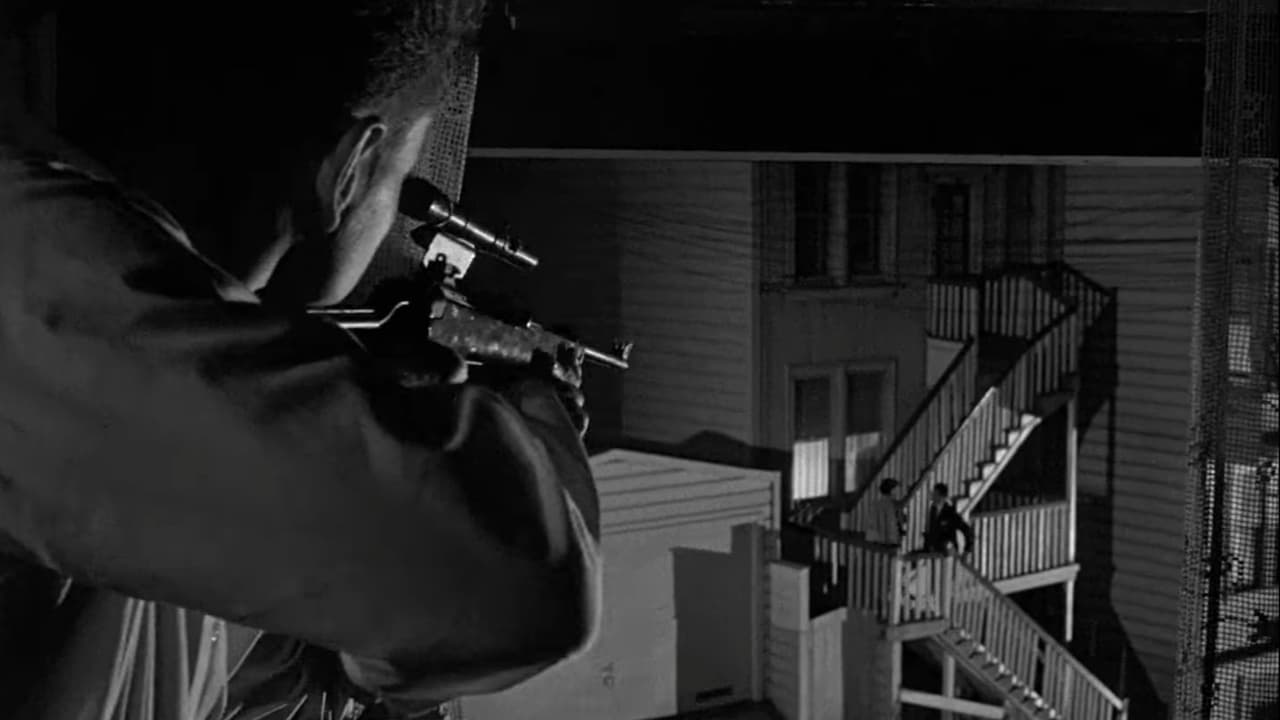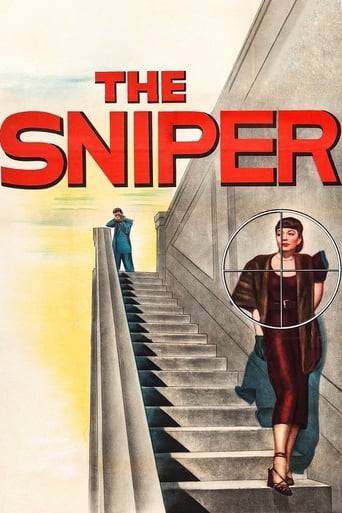

All of the reviews I have read say it well. It is an astoundingly well made movie.But the hair-raising part is that it so closely resembles the SON OF SAM shooting spree that it looks like the authors used the Son of Sam crimes as a model for the story.SPOILER ALERT---in order to show the similarities, I have to describe what happens in the movie as compared to the real life SoS happenings-- SPOILER starts HERE ---The two on-camera shootings happen with the bullets hitting and shattering glass---reminiscent of the auto windshields shattered by the .44 bulldog pistol.The fictional Sniper writes a note to the police, and Son of Sam is famous for the letters he wrote to the police and the media.Much is made both in "The Sniper" and SOS shootings, that the victims were all brunettes.The final victim in the movie is sitting with her boyfriend, just like the final victim in real life.In the final scenes, there is panic in the streets, as crowds gather to demand the sniper be killed. This looks like the scenes in New York when angry crowds screamed for Son of Sam's life. The real panic in New York, which happened over two decades later, is astoundingly portrayed by the man on the smokestack screaming for someone to pay attention.And, just as SoS was spooked by a dog, there is a scene where the fictional Sniper is spooked by an animal.And in the movie, as in SoS real life, the killer is apprehended without a fight. SPOILER ENDS HERE-----If this movie had been made yesterday, I would have thought the authors just took the SoS story, and adapted it to fiction. The fact that it was made over two decades before the SoS shootings, and so closely resembles them, is really breathtaking, and a trifle spooky. It is a really well-made movie, and actually wears its "age" very well. It does not seem like an "old" movie.
... View MoreIMDb 7.1/10 ROTTENTOMATOES 6.5/10 A young man who hates women cries for help, but no one listens to him. And so the killing begins.This film has some interesting details, like the attempt to explain the sniper's behaviour and it has a couple of pretty good scenes.Unfortunately, acting is very weak, storytelling mediocre and the psychiatrist' talks were feeling out of context (it was like being in a seminar in the middle of the movie).Probably this film was ahead of its time in 1952, but unfortunately it didn't age well.
... View MoreIn spite of the location shooting, this crime movie (certainly not a film noir) is nothing but typical, boring Stanley Kramer fare with some police procedures, a tendency of the times. It's nothing but a much too long lecture about the necessity of preventing crime by having more psychiatrists than cops and more insane asylum than prisons. It has badly aged and is quite uninteresting actually. THe characters are unbelievable, the cops as well as the preaching psychiatrist. I guess you might call it a liberal movie (though it was the Mc Carthy era) but if you're not a liberal, not a chance to be convinced by the message in the film. The idea is "criminals are human beings too and too often, society refuses to listen to them and our indifference to those suffering souls is the main cause of crime". Add to it that the crowd is cruel and insensitive (that old lady who says "I hope they'll kill him" among others) and the film was made from the point of view of the killer and its quite misogynistic : all women are horrible (he is thus to be forgiven if he kills them) especially Miller's boss. It was a strange idea to revive it on DVD as part of the Columbia Film Noir series (Movies were mostly non-noir except the very modern "Murder by contract" directed by Irving Lerner.
... View MoreThe trouble is Eddie Miller (Arthur Franz) just can't keep himself from shooting women. Plus, he does it from a distance with a sniper's rifle which makes him doubly hard to catch. Today, the sex angle would likely be played up, turning him into a serial rapist. Here, however, his sick motivation looks more like pure rage than sexual desire. Everywhere he goes, he's either humiliated or rejected by women. He's attractive enough (probably too much so to be credible), but he has a personality problem. In short, Eddie simply can't accept himself as a deliveryman; instead, he builds himself up with obvious exaggerations to impress strangers, such that when pretty barfly May Nelson approaches, he ends up offending her with wild stories. Like Psycho's Norman Bates, the problem probably goes all the way back to Mom.It's certainly a very watchable movie. The San Francisco locations are used to great effect-- the cops surveilling downtown rooftops from on high sets up a marvelous panoramic look at the city. Then too, the smokestack scene with its human fly amounts to pure cinematic magic. A problem in the film lies with too much obviousness where a lighter hand is needed. Thus, when Eddie goes on a little downtown stroll, he doesn't encounter just one woman-caused frustration, but a whole heavy-handed series of them. Too bad, because we get the idea early on that petty annoyances involving women amount to major injuries in Eddie's twisted world. Then there's the let's- hit-you-over-the-head-in-case-you-don't-get-it last scene; it's about as necessary as strip-poker at a nudist colony. Still and all, the movie's heart is in the right place, even if it appears made at times for the slow-witted.One big benefit for 50's-era fans is cult favorite Marie Windsor in a low-cut evening gown, purring her seductive lines to Eddie even as she exploits him to the hilt. What a great cameo from a really unusual actress.Too bad their scene together comes so early because it's a pip and a movie high point. Speaking of film eras, compare the themes and locations of this movie (1951) with the cinematically similar, Vietnam-era Dirty Harry (1971). Tellingly, the hopeful reformism that Kramer&Co. plead for in Sniper has been replaced by a kind of hopeless vigilantism where Harry (Clint Eastwood) ends up rejecting city hall, killing the sniper, and throwing away his policeman's badge. Mark it down to what you will, but the change-over is pretty stark and startling. Anyway, this little B-film created quite a stir at the time and remains an interesting piece of movie history, well worth thinking about
... View More